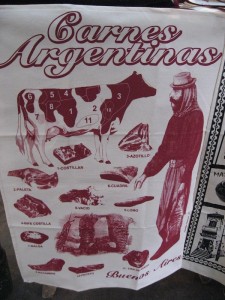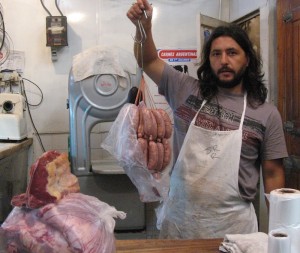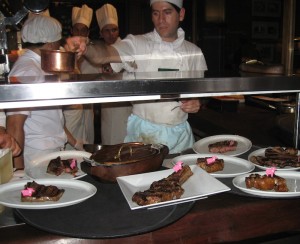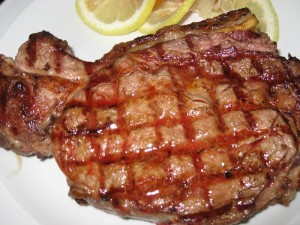Where’s the beef?
Not to worry. I found it. Actually can’t miss it. Even with a try. It is in every home, in every food outlet, on

Cuts of Argentine beef decorate a dish towel
everyone’s lips and in everybody’s heart (both literally and figuratively), throughout Argentina.
Beef is not just a food in Argentina; it is a cultural treasure, a way of life, a beloved heritage well marbled in all strata of society.
Argentines boldly boast that their beef is the best in the world. The Buenos Aires taxi driver, in route from airport to hotel, says it’s because the cows walk every day to eat and they eat only grass. The gaucho (cowboy) you meet at a street fair credits the breeds of cattle. The nutritionist trying on coats at a leather shop claims the beef has health promoting properties, absent in beef from other countries. And the cook who invites you to an asado (barbecue) insists it’s impeccable grilling techniques that release the beef’s magnificent flavor.
I say it is all of the above. Praise be the total package.
That said, don’t cry for me Argentina. We North Americans have our own beef standards and may not agree with the Argentine “best of the best” claim—that is until we become accustomed to the differences.

A Buenos Aires butcher proudly displays beef products
North Americans love long-aged, well marbled beef, served seared on the outside and bloody red inside. Argentines consider aged beef old and most order meat cooked medium well to well done. The marbling isn’t there either, as grass fed beef is much leaner than US feedlot counterparts. On the other hand, although we from the United States salivate at the thought of big, thick steaks, we find it virtually impossible to understand the gargantuan portions Argentines pack away in single sitting. Argentines eat a whopping 132 pounds of beef per person, per year, setting the world record.
Consider a typical meal in a Buenos Aires parrilla (steakhouse). Likely the meal will start with a sampling of Argentina’s favorite appetizers: beef empanadas; molleja (sweetbreads); chinchulines (intestines); rinones (kidneys); and assorted sausages, some finger thin coiled to cover the surface of a dinner plate and others as thick and succulent as any sausages on this planet. Next comes the entrée platter, which usually includes several different cuts of beef, the two most popular being bife de chorizo, a cut like a t-bone without the bone, and tira de asado, long,

Beef straight from the grill at a busy parrilla
narrow strips of bone-in short ribs. Of course, salads, potatoes and a variety of other vegetables can be ordered as side dishes. What never accompanies the beef is any sort of steak sauce, barbecue sauce or ketchup. Only salt flavors the meat. And the meat, unseasoned, not marinated, unsauced is simply irresistible.
So what really makes Argentine beef special?
Exercise, diet and living condition of the cattle play the major roles. Although Argentina does produce feedlot beef, the majority of cattle still wander freely over extensive plains, dining on rich grasses that thrive in the mild climate. A grass diet produces beef that contains less saturated fat, fewer calories, more omega 3 fatty acids and more vitamin E than other feeds. Grass-grazing, free-roaming cattle live in natural conditions and are generally free from hormone implants, stress and antibiotics.
Grass-fed beef is packed with flavor, but it can also be tough if not properly cooked and Argentines consider grilling an art form, associated with as many dos and don’ts as a religious ceremony.
Just in case you are lucky enough to get your hands on true Argentina beef and want to cook it as would an Argentine, here’s what you do:

Steak Argentine style
Barbecued Beef Argentine Style
or
RULES OF THE ASADO
- Use a grill that is scrupulously clean.
- Build a fire (coal or wood, with wood the preference as the embers last longer and perfume the meat). Let the fire burn to embers then push the embers aside, making sure you have enough embers to finish the cooking.
- Spread a portion of embers on the floor of the grill.
- When grill floor is hot, rub cooking grid with a piece of fat.
- Salt the meat before cooking—or not (salting before will draw out juices; salting after doesn’t flavor as much). Add nothing but salt to the meat.
- Place meat on grill and quickly sear the outside by lowering grill top or increasing amount of embers, then adjust grill or embers to cook the meat. Keep meat between six and four inches above the embers.
- Do not move meat around on the grill; move embers.
- Turn meat only once, with tongs; do not puncture with a fork or cut with a knife to check for doneness or you will lose juice and flavor.
- Serve the moment the meat is cooked.
- Enjoy.
